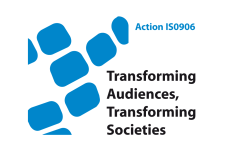- About the Action
- Events
- PhD workshop - Ljubljana 2014
- Action Open Conference - Ljubljana 2014
- New Media and Participation conference - Istanbul 2013
- Belgrade meeting 2013
- Media literacy research and policy - Brussels 2013
- ICA Pre-Conference 2013
- Tampere meeting 2013
- Budapest workshop 2012
- Milan meeting 2012
- Brussels PhD workshop 2012
- Brussels Action workshop 2012
- London meeting 2011
- Zagreb Conference 2011
- Lisbon meeting 2010
- Affiliated events
- WG 1
- WG 2
- WG 3
- WG 4
- Cross-WG
- Output
Audience research in multi-platform environments
Bolin, G. (2011). Audience research in multi-platform environments. Zagreb conference: "New challenges and methodological innovations in European media audience research". 7-9 April 2011.
Abstract: In media studies it is since long commonplace to speak about media texts “in the wider sense”. When Roland Barthes introduced the distinction between “work” (a distinct piece of content that can be attributed an author), and “text” (the negotiation of meaning that appear in the meeting of the work with an interpreting reader), qualitative audience research in the “active audience” tradition gradual came to adopt the latter concept whilst at the cost of the former. The wider textual concept used has undoubtedly shed light on the practices and meaning-making processes among readers, viewers and listeners over the past thirty years. However, with the rise of cross-media content such as “transmedia storytelling” and multiplatform productions in news and entertainment, a challenge appear for audience research: if it was easy to delimit the object of analysis in single medium settings even with the expanded textual concept, it becomes harder in multiplatform reception environments. This paper aims to discuss some methodological problems for audience research that arise from cross- media use, especially problems that arise from emergent transmedia storytelling and multiplatform media productions. It will be argued that in cross-media environments it becomes increasingly important to bring in not only analyses of the technological context of media use, but also for the return of textual analysis in combination with the analysis of media use. It will also be argued for the importance of mapping technological hierarchies in reception, and the textual hierarchies that follow, as this has methodological consequences for the analysis of media use.

